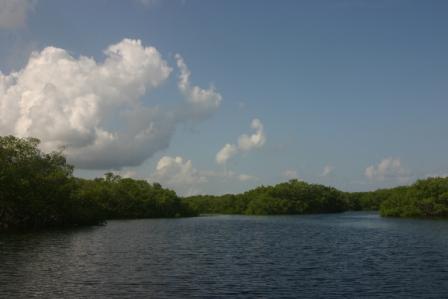There is no way that you can venture out into Charlotte Harbor or any of its surrounding bays, sounds, or tidal flats without realizing what a geographically large area it is to learn. Add in the complexities of tide, current, and wind and it can even be more complicated. Then, when you take into account our hectic daily lifestyle that limits our time on the water, learning this vast area is made even more difficult. Due to these factors, many anglers tend to keep fishing the same areas that they’re familiar with and have had success with in the past. In addition, in an effort to save time and to accelerate the learning curve, all anglers are constantly looking for any information available relating to productive new spots.
I have personally experienced both of these scenarios and it is at these times that I have to remind myself of what really draws me to the backcountry and surrounding tidal flats. It is the simple matter of exploring new country, charting spots I haven’t been and the sport of hunting down the fish. Moreover, I can honestly say that I have fished many spots in Florida and with the exception of Everglades National Park between Flamingo and Chokoloskee, there are very few places that have the sheer volume of inshore shallows, oyster bars, and backcountry mangrove islands as there are here in the country adjacent to Charlotte Harbor.
Of course, depending on your vessel, this time of year can be difficult to get around. However, the low tides can help provide great detail relating to structure, troughs, and bottom cover. This kind of knowledge can be invaluable when higher water levels return. So, if at all possible, try not to let the lower tides limit your time on the water.
A goal of mine on every trip is to make it a point to look for at least one new spot. As a result, I have found some of my best spots by just poling and working unknown shorelines and adjacent flats. It can be surprising at what you can find if you put in a little research and development time. For me, an important part of this process is keeping a detailed log of the conditions when I find a new productive spot. I will record the day, time, location, tide, wind, and moon phase. This has been instrumental in my ability to plan productive future trips. For example, if I am planning a weekend trip, I can go back to my log from the same period last year and look for similarities. The moon and tide will be almost identical, and if the wind and weather are similar, this could be a good spot to begin the day. Of course, I will then continue looking for new spots. Moreover, if you keep this pattern of exploring a routine, your list of spots will grow to the point where you have multiple choices to choose from on any individual trip.
As you begin to get used to hunting and making your way around this vast area of shallow water which includes bays, flats, mangrove islands, and backcountry creeks you will come to notice that each separate tidal flat has a lot to see. And once you learn what to look for, you will notice clues that will help provide essential information. For example, schools of bait are a great indicator. Whether it is glass minnows, sardines, or mullet, if any of these are present, there will be predator fish somewhere close by. One of my favorite ways to fish these spots is with a small soft plastic jerkbait. Gamefish have to expend a good bit of energy chasing live bait and a jerk bait bumped slowly off the bottom usually proves irresistible as easy prey. If you can identify the outside perimeter of a school, begin there before working in towards the center. This is beneficial because gamefish will first target the wounded or weaker bait that usually end up on the outside of a school.
Also, rays are an important vital sign indicating the health of a flat. They like to feed on crabs and shrimp and would not be around if there were no available food. Moreover, I always seem to see the rays first. So, If I pole a flat and there are no rays, I may just keep moving until I see at least a few rays scoot across the flat. Another good sign of an active flat are wading birds, particularly the larger herons and egrets. You will be able to tell when they are stalking small fish and it will also provide an indication of water depth. In most cases, this will be a great flat to get out and wade. Furthermore, if you are ever lucky enough to see a group of roseate spoonbills, this could be a promising spot. Shrimp is one of their favorite foods, and when there is enough water for gamefish to get in safely, they will be there.
As a final point, a quality pair of polarized sunglasses is essential if you plan to view any of the living features of a tidal flat. Still, even with this advantage, reading the water within this visual environment is a matter of experience, and you can actually begin to see things that aren’t there if you stare at any one spot too long. To help here, try to keep your eyes moving and look back across a few times towards any particular spot that initially appears like a target fish.


Recent Comments